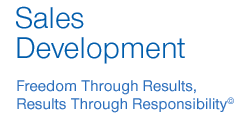Choose or Perish: 10 Steps to Creating an Over-Achieving Sales Culture
August 12th, 2016
If you are like many CEOs, your company may be experiencing the perfect storm of increased competition and price pressure, combined with a limited supply of great sales talent and financial resources. Many business owners are frustrated with the lack of new business generation and the fact that few, if any, of their people relish the role of hunting for it. Some owners even feel they being are held hostage by mediocre performers who possess valuable information or customer relationships.
The answer to this seemingly perplexing situation is YOU. By virtue of a simple choice, you possess more power than you could possibly imagine to dramatically upgrade your Sales Team and to grow now. Creating an Overachieving Sales Culture will not only fuel top line revenue growth, but can also improve your net profit. If you decide to go for it, here are some simple steps that will be required:
1. Face the Brutal Facts: Please realize that the very people you would like to change have chosen to behave the way are currently behaving. They act the way they act for only one reason–because they want to. So despite your strongest desires, they probably will not choose to do what you would like them to do – Hunt and Close. Most people, including salespeople, do not like change and will resist leaving their Comfort Zone.
2. Needle in a Haystack: Hunters & Closers represent a microscopic portion of the “salesperson population”. In fact, only a very small percentage of people are really suitable for taking on any part of a sales or business development role.
3. Use Effective Tools and Processes: You must be able to identify that small percentage of productive salespeople. This takes discipline, but isn’t hard to do if you use the right types of assessment tools and processes.
4. Raise Your Expectations, Change Your Focus, Trumpet Your Intentions: This is no time to be wimpy or ambiguous. You must loudly and clearly broadcast your unconditional commitment to create a new, effective Sales Culture. For example, let’s say you want the regional managers at your professional services company to go out and find local business clients, your customer service group to become proactive by making outgoing calls, or your service providers to bring new clients into the firm. In each of these cases, a common management mistake is to neglect the clear communication of expectations to those very people they would like to change. Be Clear.
5. Appoint a Competent Culture Transformation Director: Again, this is going to take steady commitment on your part. But it will pay off. Appoint someone who understands what needs to be accomplished as well as how to accomplish it. If your company is very small, you may need to wear the CTD hat yourself.
6. Train and Coach: Make sure that your team members are equipped with the training they’ll need to succeed in this strange new world of big selling and new business development. The assessment tools can provide you with a development roadmap.
7. Demonstrate a Path to Success: Don’t throw them out to sink or swim. Even with the most talented of salespeople, it is up to you to clearly define what it is they should do and how often they should do it.
8. Swim in the same direction: You must get complete buy-in from the people that will participate in your culture transformation. They must be All-In. Remember, your forecast and plan must be derived from your goals (not the other way around).
9. Transparency–No Surprises: Everyone must be clear as to how success will be measured, the rewards of success and the consequences of shortfalls. No Gray Areas…
10. Accountability: You and the Culture Transformation Director must create an organizational mindset where everyone is open, honest, and personally accountable. Any member of the team that doesn’t fit, doesn’t belong.
This transformation doesn’t happen overnight, if you follow these steps, it will happen. But again, it all starts with YOU.
Copyright © Joe Zente 2016. All Rights Reserved.









